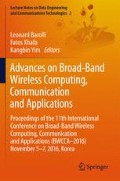Abstract
Mobile computing has many application domains. One important domain is that of mobile applications supporting collaborative work, such as, eLearning and eHealth. In such applications, a teamof people collaborate online using smartphones to accomplish a common goal, such as a project development in e-Business. Often, however, the members of the team has to take decision or solve conflicts in project development (such as delays, changes in project schedule, task asignment, etc.) and therefore members have to vote. Voting can be done in many ways, and in most works in the literature consider majority voting, in which every member of the team accounts on for a vote. In this work, we consider a more realistic case where a vote does not account equal for every member, but accounts on according to member’s active involvement and reliability in the groupwork. We present a voting model, that we call qualified voting, in which every member has a voting score according to three parameters. Then, we use fuzzy based model to compute a voting score for the member. This model is useful to implement in a P2P mobile collaborative team in replacement to majority voting as it gives more realistic view of the collaborative activity and better decisions for the groupwork, while encouraging peers to increase their reliability in order to increase their voting score.
Access this chapter
Tax calculation will be finalised at checkout
Purchases are for personal use only
Preview
Unable to display preview. Download preview PDF.
References
Oram, A. (Ed.). Peer-to-Peer: Harnessing the power of disruptive technologies. CA: O’Reilly and Associates, 2001.
T. Terano, K. Asai, and M. Sugeno, “Fuzzy Systems Theory And Its Applications”, Academic Press, INC. Harcourt Brace Jovanovich, Publishers, 1992.
F. Xhafa, and A. Poulovassilis, “Requirements for Distributed Event-Based Awareness in P2P Groupware Systems”, Proc. of AINA 2010, pp. 220-225, April 2010.
F.Xhafa, L.Barolli, S.Caball e, and R.Fernandez,“ Supporting Scenario-Based Online Learning with P2P Group-Based Systems”, Proc of NBiS 2010, pp.173-180, September 2010
S.Gupta and G. Kaiser, “P2P video synchronization in a collaborative virtual environment”, In Proceedings of the 4th international conference on Advances inWeb-Based Learning (ICWL’ 05), pp.86-98, 2005.
Ana M. Martnez-Alemn, A. M. and Wartman, K.L, “Online Social Networking on Campus Understanding What Matters in Student Culture”, Taylor and Francis, Routledge 2008.
E. Spaho, E. Kulla, F. Xhafa and L. Barolli, “P2P Solutions to Efficient Mobile Peer Collaboration in MANETs”, Proc. of 3PGCIC 2012, pp.379-383, November 2012.
Rui Joaquim, Andr e Z uquete and Paulo Ferreira. “REVS A Robust Electronic Voting System”, IADIS Int. Journal of WWW/Internet, 1(2), December 2003.
https://electology.org/score-voting.
A. Kandel, “Fuzzy Expert Systems”, CRC Press, 1992.
H. J. Zimmermann, “Fuzzy Set Theory and Its Applications”, Kluwer Academic Publishers, Second Revised Edition, 1991.
F. M. McNeill, and E. Thro, “Fuzzy Logic. A Practical Approach”, Academic Press, Inc., 1994.
L. A. Zadeh, J. Kacprzyk, “Fuzzy Logic For The Management of Uncertainty”, John Wiley & Sons, Inc., 1992.
T. J. Procyk and E. H.Mamdani, “A Linguistic Self-organizing Process Controller”, Automatica, Vol. 15, No. 1, pp. 15-30, 1979.
G. J. Klir, and T. A. Folger, “Fuzzy Sets, Uncertainty, And Information”, Prentice Hall, Englewood Cliffs, 1988.
T. Munakata, and Y. Jani, “Fuzzy Systems: An Overview”, Commun. of ACM, Vol. 37, No. 3, pp. 69-76, March 1994.
Author information
Authors and Affiliations
Corresponding author
Editor information
Editors and Affiliations
Rights and permissions
Copyright information
© 2017 Springer International Publishing AG
About this paper
Cite this paper
Liu, Y., Oda, T., Matsuo, K., Barolli, L., Xhafa, F. (2017). A Fuzzy-based System for Qualified Voting in P2P Mobile Collaborative Team. In: Barolli, L., Xhafa, F., Yim, K. (eds) Advances on Broad-Band Wireless Computing, Communication and Applications. BWCCA 2016. Lecture Notes on Data Engineering and Communications Technologies, vol 2. Springer, Cham. https://doi.org/10.1007/978-3-319-49106-6_16
Download citation
DOI: https://doi.org/10.1007/978-3-319-49106-6_16
Published:
Publisher Name: Springer, Cham
Print ISBN: 978-3-319-49105-9
Online ISBN: 978-3-319-49106-6
eBook Packages: EngineeringEngineering (R0)

